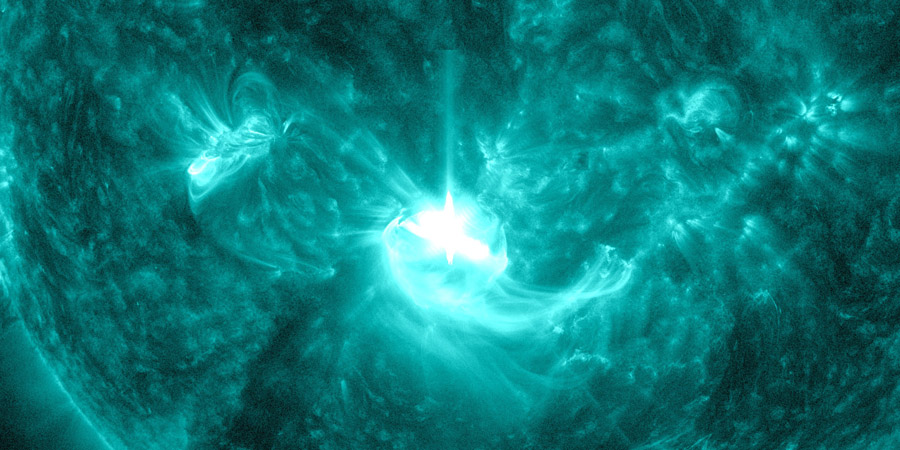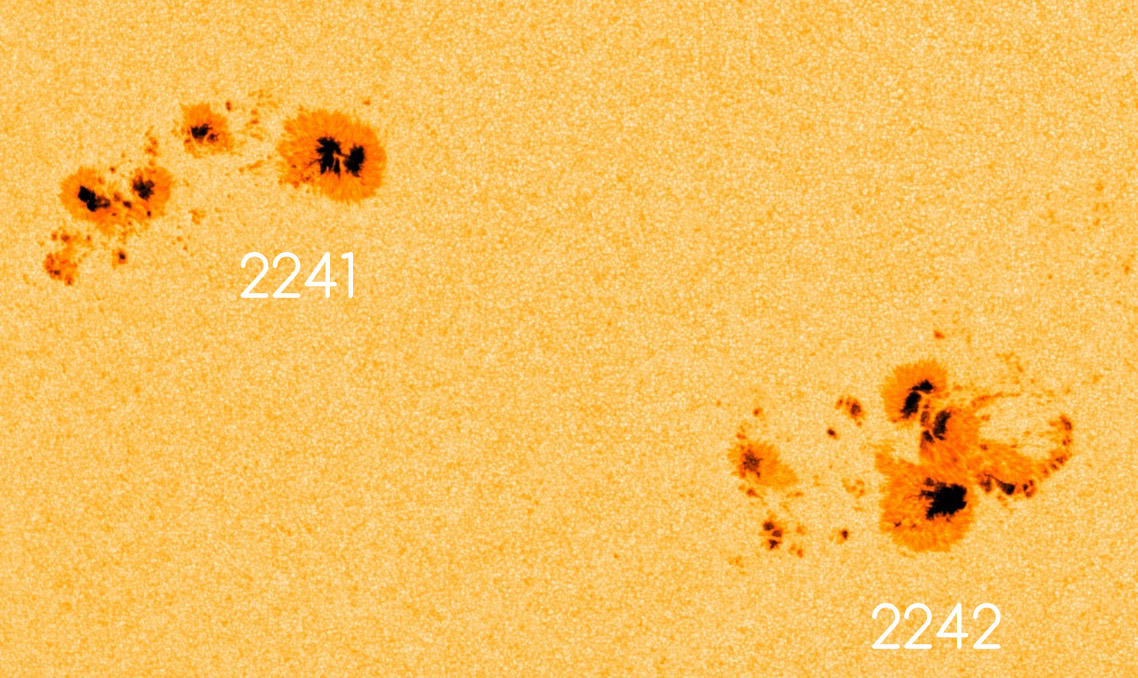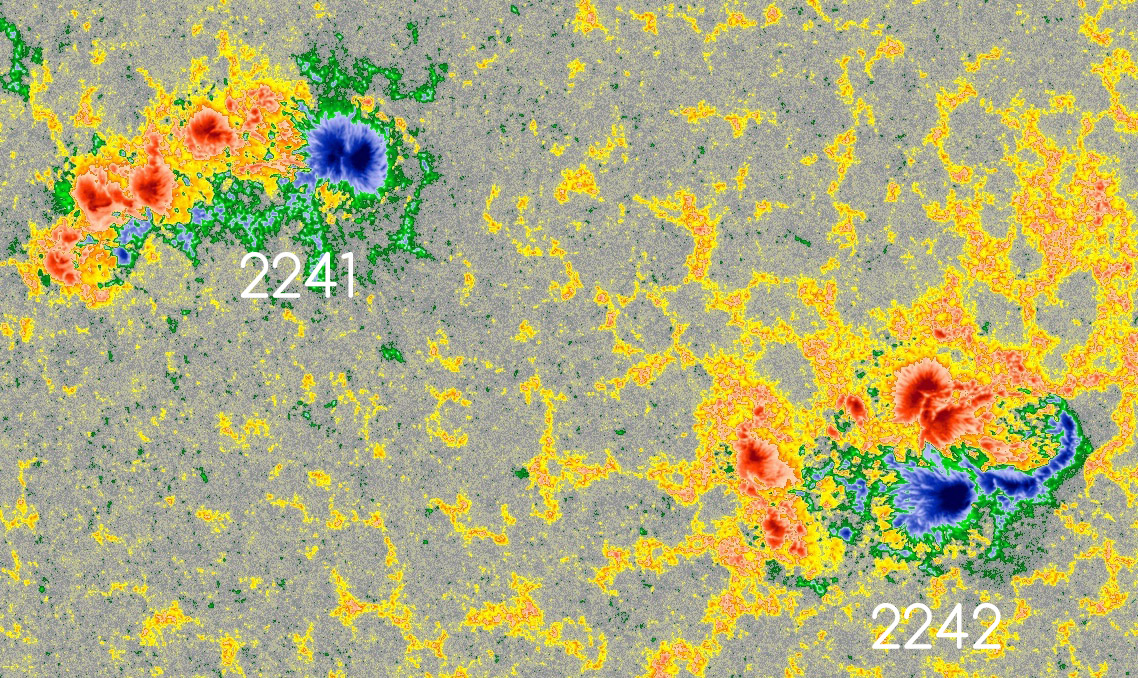M8.7 solar flare from sunspot region 2242
Wednesday, 17 December 2014 06:01 UTC

Solar activity increased to high levels thanks to sunspot region 2242, which continues to develop and gain in magnetic complexity. It produced a long duration M8.75 (R2-moderate) solar flare that peaked at 04:51 UTC which was surprisingly already the third M-class solar flare of today.
Strong M8.75 solar #flare from #sunspot region 12242 - Follow live on http://t.co/8JIfkaXUPc pic.twitter.com/7m9Nx0cpK7
— SpaceWeatherLive (@_SpaceWeather_) 17 december 2014
Sunspot region 2242 is now in a great position for Earth-directed eruptions but did this solar flare launch a coronal mass ejection? SDO imagery does show some coronal dimming following this M8 event but not to the extend that we like to see for a significant coronal mass ejection launch. There also does not seem to be an obvious large-scale coronal propagating front (shock wave trough the solar corona which is a sign that a CME was launched) which is also a sign that we might only see a minor coronal mass ejection at best from this flare. The NOAA SWPC did report Type II and IV sweeps which normally are signs that there was indeed a coronal mass ejection launched following the event.
In the hours ahead, we will wait for SOHO/LASCO coronagraph imagery to see if there was a coronal mass ejection launch and if there is one what it's trajactory will be. There will likely not be a significant coronal mass ejection but we can not rule out that some ejecta escaped the solar corona. More information will be provided later today see keep checking our website.
NOAA SWPC alerts
ALERT: X-Ray Flux exceeded M5 Threshold Reached: 2014 Dec 17 0438 UTC NOAA Scale: R2 - Moderate
SUMMARY: 10cm Radio Burst Begin Time: 2014 Dec 17 0431 UTC Maximum Time: 2014 Dec 17 0434 UTC End Time: 2014 Dec 17 0438 UTC Duration: 7 minutes Peak Flux: 320 sfu Latest Penticton Noon Flux: 185 sfu
ALERT: Type IV Radio Emission Begin Time: 2014 Dec 17 0454 UTC
SUMMARY: X-ray Event exceeded M5 Begin Time: 2014 Dec 17 0425 UTC Maximum Time: 2014 Dec 17 0451 UTC End Time: 2014 Dec 17 0520 UTC X-ray Class: M8.7 Optical Class: 2b Location: S19E09 NOAA Scale: R2 - Moderate
ALERT: Type II Radio Emission Begin Time: 2014 Dec 17 0449 UTC Estimated Velocity: 910 km/s
Two M1 solar flares
This M8.7 solar flare was actually already the third M-class solar flare that we seen today... there were also two M1 events. One at 01:10 UTC (from sunspot region 2242) and one at 01:50 UTC from region 2241. These solar flares also did not seem to be very eruptive but we will await SOHO/LASCO imagery to see if there were coronal mass ejections associated with any of these events. We will also provide information on these events later today.
Sunspot region 2241 and 2242
Sunspot region 2241 (source of an M1 solar flare at 01:50 UTC) is a large group but not very complex. It only has one small delta candidate sunspot but a Beta-Gamma layout seems more appropriate. It could produce another low-level M-class solar flare but we expect no stronger solar flare just now from it.
Star of the show is sunspot region 2242 which continues to develop and gain in magnetic complexity. We didn't even bother to indicate the deltas here as the entire leading area is one large delta that continues to grow and change. More M-class solar flares are likely with an ever increasing chance for an X-class event.
M-class flare probability for the coming 24 hours: 60% chance
X-class flare probability for the coming 24 hours: 20% chance


More information on these three M-class solar events will be provided later today when more data becomes available.
Images: NASA SDO.
Thank you for reading this article! Did you have any trouble with the technical terms used in this article? Our help section is the place to be where you can find in-depth articles, a FAQ and a list with common abbreviations. Still puzzled? Just post on our forum where we will help you the best we can!
Latest news
Latest forum messages
Support SpaceWeatherLive.com!
A lot of people come to SpaceWeatherLive to follow the Sun's activity or if there is aurora to be seen, but with more traffic comes higher server costs. Consider a donation if you enjoy SpaceWeatherLive so we can keep the website online!

Space weather facts
| Last X-flare | 2025/03/28 | X1.1 |
| Last M-flare | 2025/03/31 | M1.2 |
| Last geomagnetic storm | 2025/03/27 | Kp5 (G1) |
| Spotless days | |
|---|---|
| Last spotless day | 2022/06/08 |
| Monthly mean Sunspot Number | |
|---|---|
| February 2025 | 154.6 +17.6 |
| March 2025 | 127 -27.6 |
| Last 30 days | 127 -25.7 |


